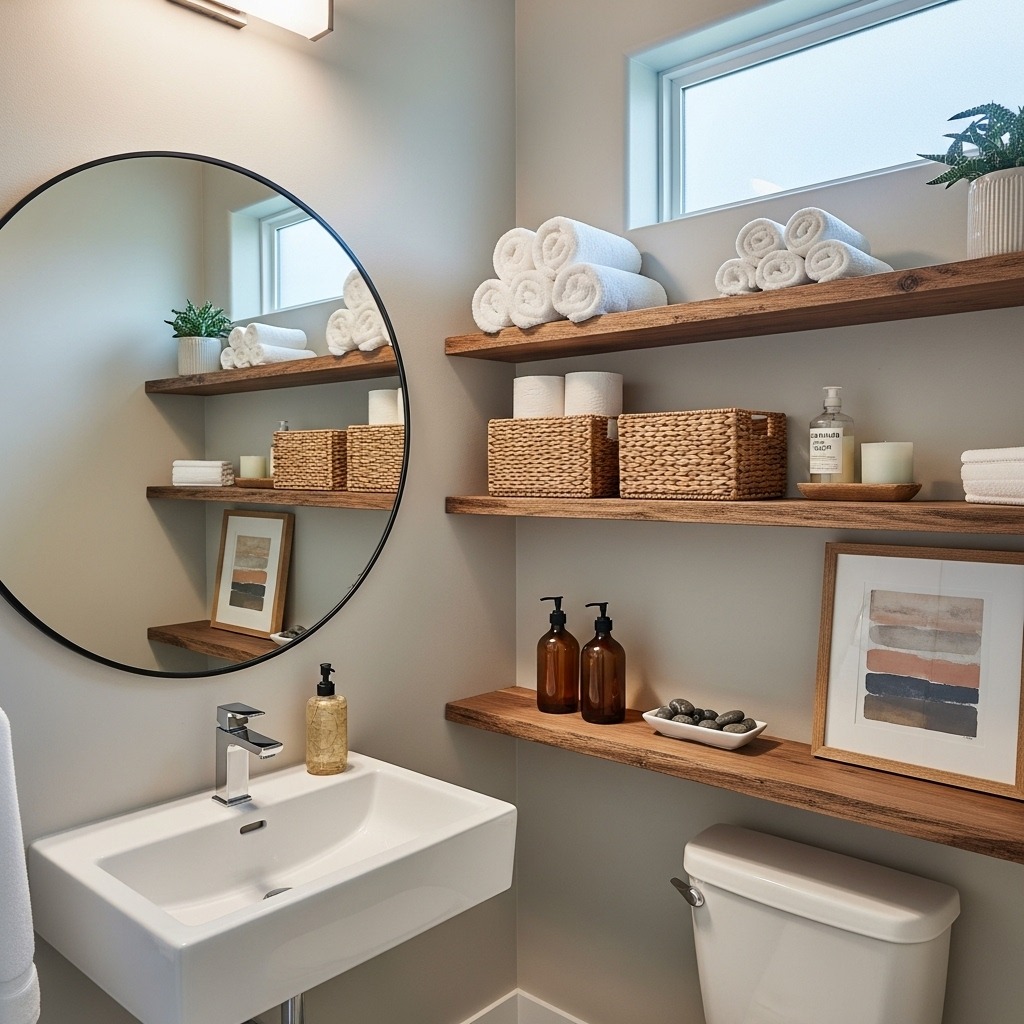For many homeowners, space is a premium, and combining two essential areas into one functional zone can be both practical and stylish.
A bathroom and laundry room combo is an efficient way to save space, improve organization, and make your home more convenient.
With the right design approach, you can create a room that looks beautiful while meeting both hygiene and utility needs.
Below are some creative and detailed bathroom and laundry room combo ideas to inspire your next remodel.
1. Maximize Vertical Space with Stacked Appliances
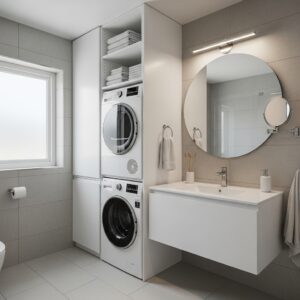
When space is tight, stacking your washer and dryer is one of the best ways to make the most of your layout.
By going vertical, you free up valuable floor space for bathroom essentials such as a vanity, toilet, or even additional storage cabinets.
Place the appliances inside a custom-built cabinet or closet to keep them hidden from view, giving the room a clean and polished look.
Adding shelving above the appliances also ensures laundry detergents, cleaning supplies, and towels are always within reach.
2. Use Built-In Cabinetry for a Streamlined Look
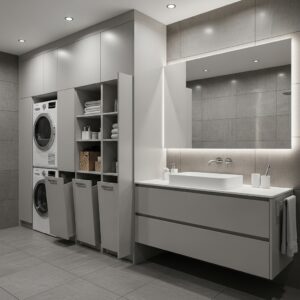
Built-in cabinetry can make a small bathroom and laundry combo feel organized and uncluttered.
You can design cabinetry around your appliances, incorporating pull-out hampers, drawers, and shelving to keep everything in order.
Consider using moisture-resistant finishes to withstand bathroom humidity.
Choosing uniform cabinet doors for both laundry storage and bathroom essentials creates a sleek and unified appearance that makes the room feel more spacious and intentional.
Read More: Apartment list moving checklist
3. Install a Multifunctional Countertop
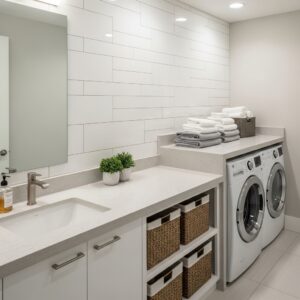
A countertop that extends over the washer and dryer doubles as a folding station and a bathroom counter.
This multifunctional feature saves space while adding a cohesive work surface to the room.
You can opt for durable materials like quartz or laminate, which are resistant to moisture and easy to clean.
If the bathroom includes a sink, the countertop can flow seamlessly from the sink area to the laundry zone, creating a continuous workspace that looks modern and practical.
4. Choose Compact Fixtures and Appliances
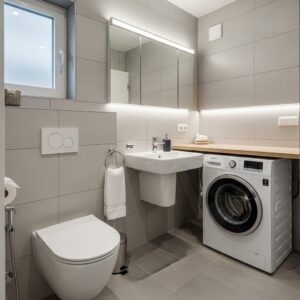
In smaller homes or apartments, every inch matters. Compact washers, dryers, and bathroom fixtures can make a huge difference in maximizing space.
Wall-hung toilets, pedestal sinks, and slim-profile appliances allow you to fit everything you need without overcrowding the room.
Choosing compact designs doesn’t mean sacrificing style—today’s appliances and fixtures come in sleek modern finishes that can elevate the overall design.
5. Incorporate Sliding or Pocket Doors
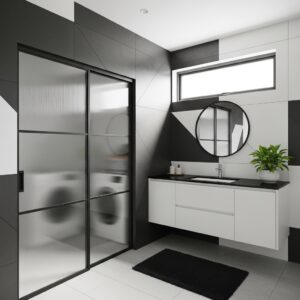
Traditional swinging doors can take up valuable floor space, making the room feel cramped.
Replacing them with sliding or pocket doors helps you maximize square footage and improve the flow between bathroom and laundry functions.
Frosted glass sliding doors can also be a stylish choice, offering privacy for the bathroom while allowing natural light to filter through, preventing the space from feeling dark or enclosed.
6. Add Clever Storage Solutions
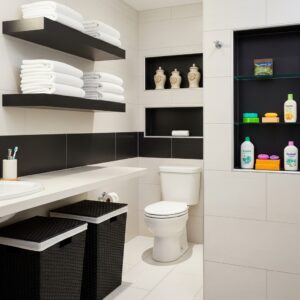
Storage is key when combining two functional rooms into one.
Open shelving can be used for towels and laundry baskets, while closed cabinets can hide cleaning supplies.
Consider built-in niches above the toilet or inside the shower for bathroom products.
Overhead hanging racks can hold air-drying laundry, while baskets or bins can help separate dirty clothes.
Thoughtful storage ensures that the room feels tidy rather than chaotic.
Read More: 10 Small Laundry Room Ideas
7. Focus on Proper Ventilation

Since both bathrooms and laundry areas create moisture, proper ventilation is critical to prevent mold and mildew.
Installing a high-quality exhaust fan that covers both the laundry and bathroom zones is essential.
If possible, adding a window can provide natural ventilation and light, making the space fresher and more inviting.
Good airflow not only protects the integrity of your appliances and finishes but also improves overall comfort.
8. Use Cohesive Design and Finishes
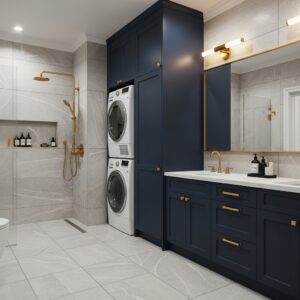
Blending bathroom and laundry room elements seamlessly requires a cohesive design.
Choose finishes, tiles, and colors that tie both functions together.
For instance, large-format tiles can cover both the shower area and the laundry wall, creating a uniform look.
Neutral color palettes with pops of accent colors, like navy or forest green, add personality while maintaining a calm and functional vibe.
Consistency in hardware, faucets, and cabinet pulls also helps unify the design.
9. Consider Hidden Laundry Zones
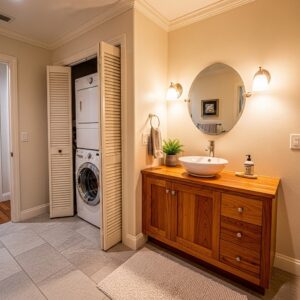
If you prefer a bathroom that looks like a bathroom first, you can design your laundry area to disappear when not in use.
Installing appliances behind bi-fold or louvered doors allows you to close them off when guests arrive.
Some homeowners even design laundry areas inside vanity-style cabinets that blend into the bathroom aesthetic.
This approach keeps the space stylish and prevents the utilitarian look of laundry appliances from dominating the room.
10. Add Luxury Touches for a Spa-Like Feel

Even though it’s a dual-purpose space, your bathroom and laundry combo doesn’t have to feel utilitarian.
Adding luxury touches, like heated floors, a rainfall showerhead, or soft ambient lighting, can transform the room into a spa-like retreat.
Pair these with high-quality finishes such as marble counters or natural wood cabinetry, and you’ll have a room that’s not only practical but also a joy to spend time in—even while doing laundry.
A bathroom and laundry room combo can be both space-saving and stylish if designed with intention.
By maximizing vertical space, using smart cabinetry, focusing on ventilation, and tying everything together with cohesive finishes, you can create a multifunctional room that looks great and works even better.
Whether you’re working with a small apartment or remodeling a family home, these ideas can help you achieve the perfect balance of practicality and comfort.
FAQS
1. Is it practical to combine a bathroom and laundry room?
Yes, combining a bathroom and laundry room is very practical, especially for smaller homes, apartments, or basements where space is limited.
It allows you to maximize square footage while keeping all water-related tasks (bathing, washing clothes, cleaning) in one zone.
With the right design elements like ventilation, storage, and layout planning, the space can be both functional and stylish.
2. How do you prevent moisture issues in a bathroom-laundry combo?
Moisture is the biggest concern in a dual-purpose room.
To prevent problems like mold and mildew, it’s important to have proper ventilation.
This includes installing a strong exhaust fan that covers both the laundry and bathroom areas, adding a window for natural airflow if possible, and using moisture-resistant materials such as tiles, quartz counters, and sealed cabinetry.
3. Can laundry appliances be safely installed in a bathroom?
Yes, but safety precautions are essential.
Since bathrooms have higher moisture levels, it’s important to ensure all outlets are GFCI-protected to avoid electrical hazards.
Appliances should be placed away from direct water sources like showers or tubs, and it’s best to enclose them in cabinetry or closets to protect them from humidity.
4. How do you keep a bathroom-laundry combo looking tidy?
The key to a tidy look is smart storage.
Built-in cabinets, pull-out hampers, hidden laundry nooks, and baskets can keep clothes and detergents out of sight.
Choosing cohesive finishes and cabinetry that match the bathroom style also helps the space look unified.
Adding sliding or pocket doors for laundry appliances can instantly make the room look neater.
5. What’s the best layout for a bathroom and laundry combo?
The best layout depends on your room size and needs. In narrow spaces, stacking appliances or tucking them behind sliding doors works best.
In larger rooms, placing laundry machines under a countertop beside the vanity creates a seamless workspace.
Always keep wet areas (showers, tubs) separated from laundry zones to prevent water splashing onto appliances.

